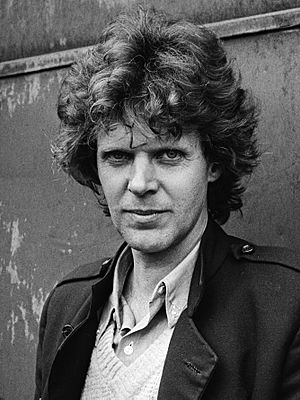Rudi van Dantzig facts for kids
Rudi van Dantzig (born August 4, 1933 – died January 19, 2012) was a famous Dutch choreographer, a director of a dance company, and a writer. He was very important in helping Dutch ballet become well-known around the world in the second half of the 1900s.
Contents
Early Life and Dance Training
Rudi van Dantzig was born in Amsterdam. His father worked in an airplane factory. His parents had strong beliefs about fairness and peace.
When Rudi was six years old, World War II started, and the German army took over the Netherlands. To keep him safe, young Rudi was sent to live in a foster home in a quieter area called Friesland.
When the Netherlands was freed in May 1945, he met Walter, a young soldier from Canada. This friendship with the soldier, who later had to leave suddenly, inspired Rudi's book, Voor een Verloren Soldaat (which means For a Lost Soldier). This book was published in 1986 and later became a movie and was translated into English.
After the war, Rudi went back to school in Amsterdam but wasn't very interested in his studies. One day, he saw the ballet movie The Red Shoes (1948) in a cinema. This movie changed his life! He watched it many times and decided he wanted to dance.
At age 16, he started taking ballet lessons. He learned from Anna Sybranda and then from Sonia Gaskell, a former dancer who ran a school and a small dance company. After the war, there weren't many male dancers. Even though Rudi wasn't the most skilled dancer, Sonia Gaskell hired him in 1954 for her company, Ballet Recital. Rudi was tall, smart, and worked very hard. He soon showed a great talent for creating dances.
In the same year, Martha Graham, a famous American dancer, visited the Netherlands. Her modern dance style greatly influenced Rudi. He saw new ways to tell stories and show feelings through dance. He then traveled to New York to learn more at her school.
A Career in Theater and Dance
In 1959, Rudi van Dantzig helped start the Netherlands Dance Theater. But in 1960, he went back to Sonia Gaskell's company, which was then called Nederlands Ballet. Later, this company joined with another one to become Het Nationale Ballet (the Dutch National Ballet). Rudi took on many important roles there.
He became a choreographer for the company in 1961. This meant he created new dances for them. He also became part of the artistic team in 1965 and a co-director in 1968. In 1971, he became the main artistic director and stayed in that job for twenty years, until 1991. He was good at managing the company and knew how to choose and create ballets that made the company and its dancers even better.
From the 1960s onwards, Rudi created more than fifty ballets. Most of his ballets were about modern topics and were made for his own company. He mixed both classical ballet and modern dance styles. His ballets often showed deep feelings and struggles that characters faced. A common idea in his works was accepting life's challenges and accepting death.
One of his best works is Four Last Songs (1977). In this ballet, he turned a piece of music about death into a beautiful dance about love. Four couples are gently separated by a character who represents death.
Rudi's unique way of mixing classical and modern dance caught the attention of Rudolf Nureyev, a very famous Russian dancer. Rudolf Nureyev asked to learn the main role in Rudi's ballet Monument for a Dead Boy. He performed it very well in England and the United States, showing he was great at both classical and modern dance.
Rudi and Rudolf became close friends. Rudolf later returned to Amsterdam and asked Rudi to create two new ballets for him: Blown in a Gentle Wind (1975) and About a Dark House (1976). Rudi wrote a book called Remembering Nureyev: The Trail of a Comet, which shares stories about their twenty-five years of friendship and working together.
In 1991, Rudi van Dantzig left the Dutch National Ballet. He wanted to focus more on writing and creating ballets for other companies around the world. He was in high demand and created works for many famous groups like the Royal Ballet and American Ballet Theatre.
Later Life and Legacy
Rudi van Dantzig felt strongly about fairness and acceptance in society. These feelings often became important themes in his ballets and writings. He shared his life and career with his partner, Toer van Schayk, who was also a dancer, designer, and choreographer with the Dutch National Ballet.
Rudi van Dantzig passed away in an Amsterdam hospital in 2012 at the age of 78.
Important Dance Works
Here are some of the ballets Rudi van Dantzig created:
- 1955. Nachteiland (Night Island)
- 1961. Jungle
- 1965. Monument voor een Gestorven Jongen (Monument for a Dead Boy)
- 1967. Romeo en Julia
- 1971. Geverfde Vogels (Painted Birds)
- 1975. Blown in a Gentle Wind
- 1977. Vier Letzte Lieder (Four Last Songs)
- 1988. Zwanenmeer (Swan Lake)
Selected Writings
Rudi van Dantzig also wrote several books and articles:
- 1986. Voor een Verloren Soldaat (For a Lost Soldier) – This book was made into a movie.
- 1993. Remembering Nureyev: The Trail of a Comet – About his friendship with Rudolf Nureyev.
- 2012. Memories of Sonia Gaskell – Published after he passed away.
Awards and Honors
Rudi van Dantzig received many awards for his work, including:
- 1956. Choreography Prize (Amsterdam)
- 1969. Knight of the Order of Orange-Nassau (a special honor in the Netherlands)
- 1985. Sonia Gaskell Award
- 2002. Lifetime Achievement Award (Prix Benois de la Danse)
- 2005. Silver Medal (Amsterdam)
See also
 In Spanish: Rudi van Dantzig para niños
In Spanish: Rudi van Dantzig para niños


